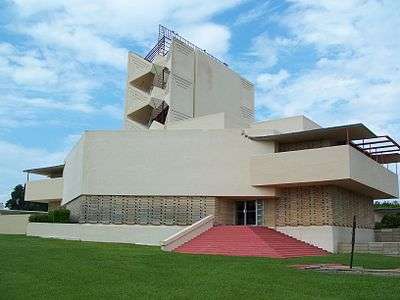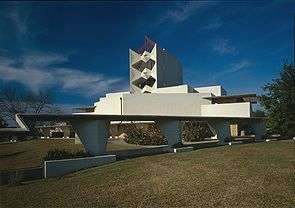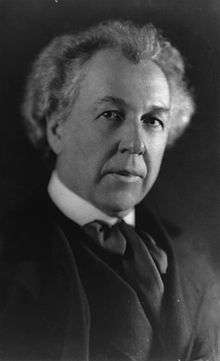Child of the Sun
|
Florida Southern College Architectural District | |
 Pfeiffer Chapel, 2009 | |
  | |
| Location | Lakeland, Florida, United States |
|---|---|
| Coordinates | 28°1′50″N 81°56′54″W / 28.03056°N 81.94833°WCoordinates: 28°1′50″N 81°56′54″W / 28.03056°N 81.94833°W |
| Area | 100 acres (0.40 km2) |
| Built | 1941-1958 |
| Architect | Frank Lloyd Wright |
| NRHP reference # | 75000568[1] |
| Significant dates | |
| Added to NRHP | June 11, 1975[1] |
| Designated NHLD | March 2, 2012[2] |
Child of the Sun, also known as the Florida Southern College Architectural District is a group of buildings designed for the campus of the Florida Southern College in Lakeland, Florida, United States, by American architect Frank Lloyd Wright from 1941 through 1958. The buildings are listed on the National Register of Historic Places, and together form the largest collection of buildings by the architect. It was designated a National Historic Landmark on March 2, 2012.[2] On April 18, 2012, the AIA's Florida Chapter ranked it eighth on its list of Florida Architecture: 100 Years. 100 Places.[3]
- Annie Pfeiffer Chapel - first completed Frank Lloyd Wright structure on the campus, dedicated 1941
- Seminars (now the Financial Aid and Business Office) - completed 1941
- Buckner Building (original Roux Library) - completed 1946
- Watson/Fine Building (Administration Building) - completed 1949
- Water Dome - partially completed 1949, completed and restored in 2007 to Wright's original plans
- Danforth Chapel - completed 1955
- Ordway Building (originally called the Industrial Arts Building) - completed 1952
- Polk County Science Building (called Polk Science by faculty and students) - completed 1958
- The Esplanades - various completion times, currently undergoing restoration around the campus
Child of the Sun Visitor Center
Opened in 1992, the "Child of the Sun" Visitor Center displays photographs, furniture, and drawings depicting Wright's relationship with Florida Southern College. The Center also displays changing exhibits on loan from other sites associated with Frank Lloyd Wright.
The Center is located in the Thad Buckner Building in the William M. Hollis Exhibition and Seminar Room, and is open during the week. A gift shop is on site, and the Center offers seasonal guided tours of the Wright-designed buildings by appointment only.
Design
Frank Lloyd Wright was retained by Florida Southern President Ludd M. Spivey in 1938 to develop a master plan for the expansion and further growth of the college's campus. Spivey gave Wright the chance to plan the campus using ideas about organic integration with the environment that the architect had been developing for some years. As basic design blocks for the campus, Wright adopted a plan based on the idea of orange groves, which have evenly spaced trees forming a grid. For construction, Wright developed the idea of textile blocks, essentially concrete blocks of standard size whose use would simplify design and construction of the buildings. These blocks would, at least in part, be formed by the college's students using local materials. The basic plan for the campus was based on ideas Wright had conceived as part of his Broadacre City idea of urban planning.[4]
Gallery
 Buckner Building
Buckner Building Danforth Chapel
Danforth Chapel Danforth Chapel
Danforth Chapel Danforth Chapel
Danforth Chapel Danforth Chapel (original FLW designed pew)
Danforth Chapel (original FLW designed pew) Esplanade (walkway)
Esplanade (walkway) Esplanade (walkway)
Esplanade (walkway) Esplanade (walkway) night
Esplanade (walkway) night Esplanade (walkway) pillar
Esplanade (walkway) pillar Ordway Building
Ordway Building Ordway Building
Ordway Building Ordway Building (interior courtyard)
Ordway Building (interior courtyard) Ordway Building
Ordway Building Pfeiffer Chapel, 1941
Pfeiffer Chapel, 1941 Pfeiffer Chapel
Pfeiffer Chapel Pfeiffer Chapel
Pfeiffer Chapel Polk Science Building (only FLW designed planetarium)
Polk Science Building (only FLW designed planetarium) Polk Science Building
Polk Science Building Seminar Building
Seminar Building Water Dome (fountain on)
Water Dome (fountain on) Water Dome pool
Water Dome pool
See also
References
- 1 2 National Park Service (2010-07-09). "National Register Information System". National Register of Historic Places. National Park Service.
- 1 2 Weekly List Of Actions Taken On Properties: 3/12/12 through 3/16/12
- ↑ Florida Architecture: 100 Years. 100 Places
- ↑ "NHL nomination for Florida State College Historic District" (PDF). National Park Service. Retrieved 2018-01-13.
External links

- Historic American Buildings Survey (HABS) No. FL-323, "Florida Southern College, McDonald & Johnson Avenues, Lakeland, Polk County, FL", 53 photos, 22 data pages, 4 photo caption pages
- HABS No. FL-323-A, "Florida Southern College, Annie Pfeiffer Chapel", 11 photos, 5 color transparencies, 2 photo caption pages
- HABS No. FL-323-B, "Florida Southern College, William H. Danforth Chapel", 3 photos, 1 color transparency, 2 photo caption pages
- HABS No. FL-323-C, "Florida Southern College, Emile E. Watson Administration Building", 9 photos, 1 color transparency, 2 photo caption pages
- HABS No. FL-323-D, "Florida Southern College, E. T. Roux Library", 6 photos, 1 color transparency, 2 photo caption pages
- HABS No. FL-323-E, "Florida Southern College, Esplanade (Walkway)", 4 photos, 1 photo caption page
- HABS No. FL-323-F, "Florida Southern College, Polk Science Building", 10 photos, 1 photo caption page
- HABS No. FL-323-G, "Florida Southern College, Lucius Ordway Arts Building", 7 photos, 1 photo caption page
- HABS No. FL-323-H, "Florida Southern College, Auditorium-Music Building", 4 photos, 1 photo caption page
- Critique of the Child of the Sun
- Child of the Sun Visitor Center
